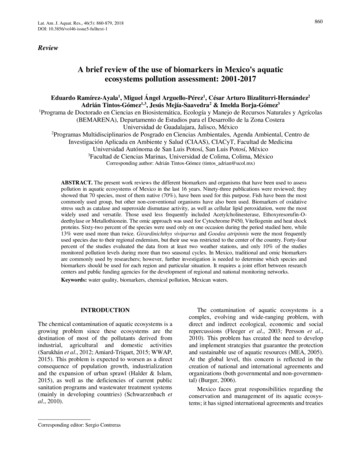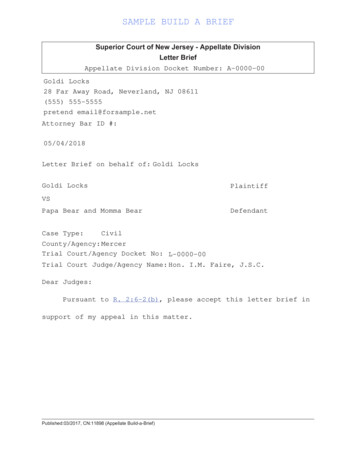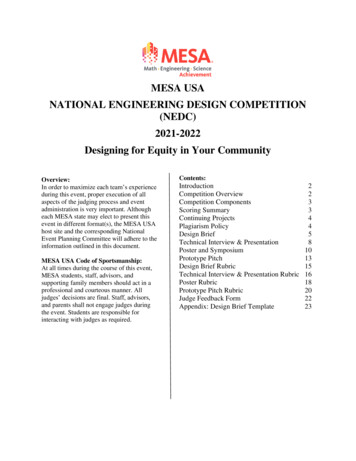
Transcription
Lat. Am. J. Aquat. Res., 46(5): 860-879, 2018DOI: 10.3856/vol46-issue5-fulltext-1Aquatic contamination biomarkers in Mexico8601ReviewA brief review of the use of biomarkers in Mexico's aquaticecosystems pollution assessment: 2001-2017Eduardo Ramírez-Ayala1, Miguel Ángel Arguello-Pérez1, César Arturo Ilizaliturri-Hernández2Adrián Tintos-Gómez1,3, Jesús Mejía-Saavedra2 & Imelda Borja-Gómez31Programa de Doctorado en Ciencias en Biosistemática, Ecología y Manejo de Recursos Naturales y Agrícolas(BEMARENA), Departamento de Estudios para el Desarrollo de la Zona CosteraUniversidad de Guadalajara, Jalisco, México2Programas Multidisciplinarios de Posgrado en Ciencias Ambientales, Agenda Ambiental, Centro deInvestigación Aplicada en Ambiente y Salud (CIAAS), CIACyT, Facultad de MedicinaUniversidad Autónoma de San Luis Potosí, San Luis Potosí, México3Facultad de Ciencias Marinas, Universidad de Colima, Colima, MéxicoCorresponding author: Adrián Tintos-Gómez (tintos adrian@ucol.mx)ABSTRACT. The present work reviews the different biomarkers and organisms that have been used to assesspollution in aquatic ecosystems of Mexico in the last 16 years. Ninety-three publications were reviewed; theyshowed that 70 species, most of them native (70%), have been used for this purpose. Fish have been the mostcommonly used group, but other non-conventional organisms have also been used. Biomarkers of oxidativestress such as catalase and superoxide dismutase activity, as well as cellular lipid peroxidation, were the mostwidely used and versatile. Those used less frequently included Acetylcholinesterase, Ethoxyresorufin-Odeethylase or Metallothionein. The omic approach was used for Cytochrome P450, Vitellogenin and heat shockproteins. Sixty-two percent of the species were used only on one occasion during the period studied here, while13% were used more than twice. Girardinichthys viviparrus and Goodea atripinnis were the most frequentlyused species due to their regional endemism, but their use was restricted to the center of the country. Forty-fourpercent of the studies evaluated the data from at least two weather stations, and only 10% of the studiesmonitored pollution levels during more than two seasonal cycles. In Mexico, traditional and omic biomarkersare commonly used by researchers; however, further investigation is needed to determine which species andbiomarkers should be used for each region and particular situation. It requires a joint effort between researchcenters and public funding agencies for the development of regional and national monitoring networks.Keywords: water quality, biomarkers, chemical pollution, Mexican waters.INTRODUCTIONThe chemical contamination of aquatic ecosystems is agrowing problem since these ecosystems are thedestination of most of the pollutants derived fromindustrial, agricultural and domestic activities(Sarukhán et al., 2012; Amiard-Triquet, 2015; WWAP,2015). This problem is expected to worsen as a directconsequence of population growth, industrializationand the expansion of urban sprawl (Halder & Islam,2015), as well as the deficiencies of current publicsanitation programs and wastewater treatment systems(mainly in developing countries) (Schwarzenbach etal., 2010).Corresponding editor: Sergio ContrerasThe contamination of aquatic ecosystems is acomplex, evolving and wide-ranging problem, withdirect and indirect ecological, economic and socialrepercussions (Fleeger et al., 2003; Persson et al.,2010). This problem has created the need to developand implement strategies that guarantee the protectionand sustainable use of aquatic resources (MEA, 2005).At the global level, this concern is reflected in thecreation of national and international agreements andorganizations (both governmental and non-governmental) (Burger, 2006).Mexico faces great responsibilities regarding theconservation and management of its aquatic ecosystems; it has signed international agreements and treaties
2861Latin American Journal of Aquatic Researchon the matter and has implemented laws, norms andnational policies that promote the conservation of itsaquatic ecosystems. It has also instituted monitoringprograms such as the National Network of WaterQuality Monitoring (RNM) (Comisión Nacional delAgua, 2015).Environmental monitoring programs are a crucialtool to meet the commitments acquired in internationaltreaties and conventions (such as the Minamataagreement, recently ratified by several countries of theEuropean Union and by Mexico in 2015), and toguarantee the success of natural resource managementprograms. For several decades, aquatic monitoringprograms and networks have worked in other countries,keeping track of changes in water quality (physical,chemical and microbiological), the presence andconcentration of persistent toxic substances (metals,pesticides, etc.) in various environmental matrices(water, sediments, biota), and applying biotic indicesbased on diverse species (plants, mollusks andmacroinvertebrates, among others) to determine thehealth status of the monitored ecosystems (Dixon &Chiswell, 1996; Markert et al., 2003; Li et al., 2010;Borja et al., 2015).The use of indicator species (bioindicators) made itpossible to evaluate the biological response to thepresence of contaminants (known and unknown) indifferent ecosystems. The implementation of tools suchas Indices of Biotic Integrity (IBI), for example,provides information on the medium and long-termeffect of contaminants at the higher levels of biologicalorganization (populations and/or communities) (De laLanza-Espino & Hernández-Pulido, 2014; SchmitterSoto, 2014).The need to identify earlier the effect of pollutantsstimulated the use of early-response biomarkers. Eventhough they have been widely used by researchers forseveral decades to assess pollution in aquaticecosystems, the use of biomarkers in monitoringprograms is relatively new (Hook et al., 2014; Trapp etal., 2014). In recent decades, the U.S.A. and somecountries of the European Union have incorporated theuse of biomarkers into national monitoring programs(Collier et al., 2012; Wernersson et al., 2015).However, in other countries biomarkers are still littleused in national monitoring programs (Trapp et al.,2014). In Mexico, biomarkers have been little used inlarge-scale monitoring programs (temporal andspatial), but Mexican researchers have been using themto assess the contamination of aquatic ecosystems. Theobjective of this work was to conduct a review of thedifferent biomarkers and organisms that have been usedto evaluate the pollution of aquatic ecosystems inMexico in the last 16 years (2001-2017).Selection of bibliographic materialDifferent academic databases and search engines(Elsevier-Scopus, SCIELO, CONRICyT, and GoogleScholar) were queried for scientific publications on theuse of biomarkers to assess the pollution of aquaticecosystems in Mexico (including studies that evaluatedenvironmental samples). The search queries includedcombinations of keywords such as Mexico, ecosystems, aquatic, lagoon, estuary, bay, lake, river, wetland,pollution, pollutant, COPs, heavy metals, PCBs, PAHs,biomonitor, biomarker, genotoxic, histopathological,oxidative stress, cytotoxic, aquatic organisms, fish,bivalves, clams, crustaceans, aquatic birds, rotifers, andcladocerans, among others, both in Spanish and inEnglish. The search range was from 2001 to 2017. Thefollowing criteria were used for selecting articles, andbook chapters: 1) studies conducted in Mexican aquaticecosystems, 2) field or laboratory studies (in the case oflaboratory studies, those using water and/or sediment asexposure matrix, excluding air), and 3) studies on theuse of biomarkers of effect and/or exposure, at theindividual and/or sub-individual level.Selected studiesNinety-three publications were selected based on theabove criteria. The chosen studies provide a representative picture of the field even though the totalnumber of related studies conducted in Mexico duringthe studied period is higher (Dalzochio et al., 2016).The number of associated publications per year in theperiod 2001-2017 had an upward trend, with an averageof 5.5 papers per year (Fig. 1). The growing number ofpublications may be related to the increase in spendingon science and technology by Mexico, which went from0.31% of Gross Domestic Product (GDP) in 2000 to0.55% of GDP in 2015. This type of research isfinanced mostly by federal and state funds through theNational Council of Science and Technology(CONACyT). Although it has made some progress,Mexico is still one of the of OECD countries that investless in science, given that the average spending onscience of the member countries of the OECD wasabout 2.5% of GDP in 2015 (UNESCO, 2015; WorldBank, 2018).Use of reference organisms as biomarkersIn general, bioindicator organisms can be defined aswhole organism systems with one or more easilydetectable endpoints (for example, viability, metabolism, behavior, genetic damage, etc.) that respond todisturbances in their environment (Butterworth et al.,2001), and which due to their ecological characteristics(Páez-Osuna & Osuna-Martínez, 2011; Berthet, 2012;González-Zuarth & Villarino, 2014) can be used asindicators of the ecological status of the ecosystems in
Aquatic contamination biomarkers in Mexico8623Number of articles 2017Year of publicationFigure 1. Number of published articles on the use of biomarkers to assess pollution in aquatic ecosystems in Mexico (20012017).in which they inhabit. The use of bioindicators for theassessment of pollution allows for a more realisticanalysis of the effect of various pollutants in differentecosystems, at the population, community and ecosystem level. Moreover, the use of the biomarker approachbased on reference species provides information on themolecular, cellular, physiological and individual levelsof an ecosystem (Van-der Oost et al., 2003). In thisregard, ecotoxicology can serve to evaluate the earlyeffect of various pollutants through the use of a seriesof tools (molecular tests, bioassays, transplantation oforganisms, etc.) that include not only ecologicallyrelevant species, but also model organisms, transgenicorganisms and even cell lines (human and animal)(Zhang et al., 2013; Lee et al., 2015). Currently, a largenumber of organisms (both wild and model) are used asbioindicators in pollution assessment studies in aquaticecosystems; the most commonly used are fish (marineand freshwater), bivalves (marine), cladocerans,rotifers, macro-crustaceans, plants, and birds, amongothers (Zhou et al., 2008; Li et al., 2010; Minier et al.,2015; Colin et al., 2016).Table 1 shows the variety of species that have beenused in Mexico in biomarker studies to assess thepollution of aquatic ecosystems. The review of the dataindicates that, in the last 16 years, close to 70 species,belonging to 19 taxa, have been used in this manner,fish being the most commonly used. Other groups ofinterest are cladocerans and bivalves. Non-conventional organisms such as turtles, sharks, crocodiles, andcorals have also been used (Fig. 2).Regarding the frequency with which the differentspecies have been used, 62% of the species identifiedin the present study had only a single record between2001-2017; 25% of the species had two records, and theremaining 13% were used in three or more studies. It isworth noting that of the nearly 70 species used, 50 arenative to Mexico and were used in 62% of the studies;8 can be considered as model species that are widelyused in laboratories in different countries and were usedin 25% of the total number of studies reviewed here.Another seven species can be considered an exoticspecies that have been introduced to Mexico(ornamental or aquaculture species) and were used in8% of the studies. The remaining species were notidentified (5%). The species that were most frequentlyused during the period under review are shown (Fig. 3).The above data shows the great variety of nativespecies that have been used to assess the pollution ofaquatic ecosystems in Mexico. It is an indication of theefforts made to diversify the organisms used asbioindicators. Thus, improving the accuracy of thebiological response by using the regions’ nativeorganism, or by comparing the response of differentorganisms at different trophic levels, is especiallyimportant for countries such as Mexico, which has agreat variety of bioclimates. Moreover, the data showsthat most native species were used only in one or twostudies during the entire period under review, whichmakes it difficult to compare different experiences withthe same species under different environmentalconditions.In contrast, model species such as Daphnia magnaand Cyprinus carpio have been frequently used (Fig. 2).These organisms have been validated in manycountries; however, since they are not representative ofthe ecosystems studied, their response cannot beconsidered entirely realistic. To make valid interpretations of the effects of pollution in a given ecosystem,researchers should use local species as bioindicators. In
4863Latin American Journal of Aquatic ResearchTable 1. Basic information of the reviewed studies on the use of biomarkers to assess pollution in aquatic ecosystems inMexico: 2001-2017. The column titled Origin refers to the origin of the organisms used, classifying them into the followingcategories. Model, refers to model organisms or organisms widely used in toxicological or ecotoxicological studies aroundthe world; Native, refers to organisms that are native to Mexico; N/A: not applicable; N/E: not specified; Exotic, refers toorganisms that are exotic to Mexico according to González et al. (2014). *Cortez-Gómez et al. (2018) was reviewed in2017 when it was still in press.SpeciesLimnodrilus hoffmeisteriLimnodrilus hoffmeisteriLecane quadridentataDaphnia magnaDaphnia pulexSimocephalus vetulusDaphnia magnaNo identificadoStagnicola sp.Xiphophorus helleriiXiphophorus helleriiGoodea atripinnisAmeca splendensAriopsis assimilisDanio rerioDendrocygna autumnalisOreochromis niloticusGirardinichthys viviparusGambusia yucatanaCrassostrea virginicaSorghum bicolorDaphnia pulexLactuca sativaLecane quadridentataDaphnia magnaAmeca splendensGoodea atripinnisXenotoca melanosomaOreochromis aureusChirostoma consociumChirostoma luciusLepomis macrochirusAlloophorus robustusZoogoneticus quitzeoensisChapalychthys encaustusPoeciliopsis infansGoodea atripinnisChelonia mydas agassiziiGirardinichthys viviparusCarcinogenic cells MCF-7Ariopsis felisHaemulon plumieriSimocephalus mixtusDaphnia magnaGirardinichthys viviparusMegapitaria squalidaCrassostrea virginicaPocillopora capitataGoodea iveNativeNativeReferenceFlores-Tena & Martínez-Tabche, (2001)Martínez-Tabche et al. (2001)Rico-Martínez et al. (2001)[1][2][3]Villegas-Navarro et al. (2001)Favari et al. (2002)Martínez-Tabche et al. (2002)Favari et al. (2003)López -López et al. (2003)[4][5][6][7][8]Noreña-Barroso et al. (2004)Báez-Ramírez & García-Prieto (2005)Rendón-Von Osten et al. (2005)Gold-Bouchot et al. (2006)López-López et al. (2006)Rendón-Von Osten et al. (2006)Gold-Bouchot et al. (2007)López-Hernández et al. (2007)Sánchez-Meza et al. drano et al. (2007)[18]Tejeda-Vera et al. (2007)[19]Torres-Bugarin et al. (2007)[20]Valdivia et al. (2007)Vega-López et al. (2007)[21][22]Zapata-Pérez et al. (2007)Alpuche-Gual & Gold-Bouchot (2008)Martínez-Jerónimo et al. (2008)[23][24][25]Vega-López et al. (2008)Cantú-Medellín et al. (2009)Guzmán- Garcia et al. (2009)Liñán-Cabello et al. (2009)Reinoso-Silva et al. (2014)[26][27][28][29][30]
8645Aquatic contamination biomarkers in MexicoContinuationSpeciesGirardinichthys viviparusCrassostrea corteziensisMegapitaria squalidaAriopsis felisCentropous parallelusOreochromis sp.Mugil cephalusCyprinus carpioAnkistrodesmus falcatusHyallela aztecaAmbystoma mexicanumChelonia mydasCaretta carettaLepidochelys olivaceaNassarius vibexDaphnia magnaPanagrellus redivivusVibrio fischeriSalmo truttaMugil curemaLecane quadridentataDaphnia magnaPandion haliaetusEchinolittorina ziczacCerithium lutosumGoodea atripinnisChelonia mydasGoodea atripinnisDanio rerioAstyanax aeneusChirostoma riojaiCrassostrea virginicaPrionace glaucaCupleidae spp. (embryo)Goodea atripinnisPrionace glaucaCrassostrea corteziensisRhinella marinaRhinella marinaVicia fabaGoodea gracilisCyprinus carpioAstyanax aeneusNot identifiedIsurus oxyrinchusLactuca sativaChirostoma jordaniCyprinus carpioCyprinus carpioDaphnia magnaCrassostrea gigasAnkistrodesmus falcatusHumansCrocodylus moreletiiPlicopurpura ticModelN/ANativeNativeReferenceVega-López et al. (2009)Bernal-Hernández et al. (2010)Escobedo-Fregoso et al. (2010)González-Mille et al. (2010)[31][32][33][34]Galar-Martínez et al. (2010)López-López et al. (2010)[35][36]Richardson et al. (2010)[37]Rodríguez-Romero (2010)Salazar-Coria et al. (2010)[38][39]Ríos-Sicarios et al. (2010)Torres-Guzmán et al. (2010)[40][41]Rivera-Rodríguez & Rodriguez-Estrella (2011)[42]Arévalo-Hernández et al. (2011)Labrada-Martagón et al. (2011)López-López et al. (2011)Rodríguez-Fuentes et al. (2011)Trujillo-Jimenez et al. (2011)Vega-López et al. (2011)Aguilar et al. (2012)Barrera-Garcia et al. (2012)Jaward et al. (2012)Ruiz-Picos & López-López (2012)Barrera-Garcia et al. (2013)Girón-Pérez et al. (2013)González-Mille et al. (2013)Ilizaliturri-Hernández et al. (2013)Juárez-Santa Cruz et al. (2013)Olivares-Rubio et al. (2013)San juan- Reyes et al. (2013)Trujillo-Jiménez et al. (2013)Vega-López et al. (2013)Vélez-Alvez et al. (2013)Rodríguez-Romero et al. (2014)Dzul-Caamal et al. (2014)García-Nieto et al. (2014)González-González et al. (2014)Mejía-Saavedra et al. (2014)Vázquez-Boucard et al. (2014)Abeja-Pineda et al. (2015)Alvares-Moya & Reynoso-Silva (2015)Buenfil-Rojas et al. (2015)Domínguez-Ojeda et al. 6][67][68][69][70][71][72]
6865Latin American Journal of Aquatic ResearchContinuationSpeciesCyprinus carpioCyprinus carpioGirardnichthys viviparusGoodea atripinnisCyprinus carpioSelenastrum capricornutumDaphnia magnaCrocodylus moreletiiGirardinichthys viviparusFulica americanaChirostoma jordaniAmbystoma mexicanumHyalella aztecaCyprinus carpioAmbystoma mexicanumCrassostrea corteziensisCrassostrea sp.Lepidochelys olivaceaRhincodon typusHaemulon aurolineatumOcyurus chrysurusDaphnia magnaLecane quadridentataFulica americanaCyprinus NativoNativeExoticModelModelNativeModelMexico, species such as Goodea atripinnis andGirardinichthys viviparus have been frequently used toassess pollution in aquatic ecosystems, mainly in thecenter of the country. Other species such as Crassostreavirginica and C. corteziensis have been used in theMexican northwestern Pacific coast; in addition tobivalves (for example Crassostrea and Megapitaria),they have proven to be very useful in this environmentdue to their excellent qualities as bioindicators (PáezOsuna & Osuna-Martínez, 2011). Other organismsconsidered validated in Mexico, include Gambusiayucatana (Rendón-Von Osten, 2015), cladocerans(Mendoza-Cantú et al., 2013) and rotifers (RicoMartínez et al., 2013). However, these organisms havebeen little used to evaluate the effect of pollution onenvironmental samples (in situ or ex-situ). Probably bebecause these and other species used as bioindicatorsare endemic to specific regions of the country, as is thecase of Goodea atripinnis and Girardinichthysviviparus, a consequence of the climatic and orographicdiversity of Mexico (Dzul-Caamal et al., 2012).Use of biomarkersBiomarkers provide information on the early effects ofexposure to environmental pollutants at organism orsub-organism levels, allowing researchers to detect andReferenceMorachis-Valdez et al. (2015)Neri-Cruz et al. (2015)Olivares-Rubio et al. (2015)Ruiz-Picos et al. (2015)San juan- Reyes et al. (2015)Sobrino-Figueroa et al. (2015)[73][74][75][76][77][78]Dzul-Caamal et al. (2016)Dzul-Caamal et al. (2016)López-Islas et al. (2016)López-López et al. (2016)[79][80][81][82]Novoa-Luna et al. (2016)Olvera-Néstor et al. (2016)Ortiz-Ordoñez et al. (2016)Toledo-Ibarra et al. (2016)Bautista-Covarrubias et al. (2017)Cortez-Gómez et al. (2018)*Fossi et al. (2017)Gold-Bouchot et al. énez et al. (2017)[91]López-Islas et al. (2017)Pérez-Coyotl et al. (2017)[92][93]quantify these effects during their first manifestations,facilitating the implementation of a rapid preventiveand/or restorative response in impacted ecosystems(Amiard-Triquet & Berthet, 2015). Biomarkers can bedefined as biochemical, cellular, physiological orbehavioral variations that can be measured in fluid ortissue samples at the whole organism level and whichprovide evidence of exposure to and/or effect of one ormore pollutants (Van der Oost et al., 2003).For several decades, biomarkers have been widelyused by researchers to assess the effect of environmental pollution and have recently been integrated intomonitoring programs in some countries (Collier et al.,2012; Wernersson et al., 2015). Biomarkers can beclassified into effect biomarkers, exposure biomarkersand susceptibility biomarkers (Van der Oost et al.,2003), or into defense biomarkers, damage biomarkers,energy biomarkers and behavioral biomarkers(Amiard-Triquet & Berthet, 2015). It is well known thatbiomarkers can be influenced by variation factors(Forbes et al., 2006) that are both intrinsic and extrinsicto the test organism (Amiard-Triquet & Berthet, 2015).However, several biomarkers have been validated, bothin laboratory and field tests. Thus, they can be usedsuccessfully, with due precautions (Forbes et al.,2006), and thanks to their specificity (see Rendón-
Aquatic contamination biomarkers in Mexico8667454035302520151050Num. of speciesNum. of studiesFigure 2. The number of species of each group of organisms used as bioindicators, and the number of studies in which theyhave been used. The total number of studies differs from the total number of articles because some studies used more thanone species.Figure 3. Most used species in biomarker studies in Mexico between 2001 and 2017. The total number of studies differsfrom the total number of articles because some studies used more than one species.Von Osten, 2005 and Hook et al., 2014 for an in-depthdiscussion of the biomarkers specificity mostcommonly used to evaluate aquatic contamination), todetermine the presence and effects of various pollutants(metals, PAHs, pesticides and estrogenic compounds,mainly). Which is why several of these biomarkers arewell recommended for regulatory applications andmonitoring programs (Roméo & Giambérini, 2012).The selection of suitable biomarkers for use inecotoxicological studies depends on several factors,including the type of pollutant to be evaluated, thereference species, or even technical and budgetaryfactors (Rendón-Von Osten, 2005). The present workfound that a great variety of biomarkers have been usedin Mexico to evaluate the effect of pollution in theaquatic ecosystems. The biomarkers that have beenused, the associated organisms, and the differentpollution scenarios in which they have been used areshown (Table 2). In this Table we shown the complexpollution conditions that can be found in aquaticecosystems in Mexico; it also shows that the mostcommonly used biomarkers, which were associatedwith a wide variety of organisms, are non-specific andof the rapid response type, such as biomarkers ofoxidative stress, which include CAT, SOD, andTBARS, among others. This strategy is recommendedfor complex pollution scenarios because these biomarkers respond to a wide variety of pollutants andmixtures of contaminants. These characteristics makethis type of biomarker a versatile and relatively cheaptool that can be suitable for a first assessment of theeffect of pollution on aquatic ecosystems in complexpollution scenarios.
8867Latin American Journal of Aquatic ResearchSpecific biomarkers such as δ-ALAD, which isspecific for lead (Wernersson et al., 2015), and semispecific biomarkers such as Vitellogenin, AChE,EROD and MT's, among others, were also used duringthe period under review. These biomarkers can be usedas evidence of the presence of a group of pollutants(heavy metals, PAHs, organophosphates, pharmaceuticals) when no previous evidence has been found, or tocorrelate the level of response to a given concentrationof the pollutant when its presence is already known. InMexico, specific and non-specific biomarkers havebeen used simultaneously in different scenarios.Some researchers recommend the use of biomarkersin association with the so-called omic sciences (mainlygenomics, transcriptomics, proteomics, and metabolomics) (Martyniuk & Simmons, 2016). These newapproaches offer a number of advantages that allow anin-depth analysis of the effect of pollutants onbiological systems, which can be used to find new andbetter biomarkers, and to shorten the time to implementpreventive and/or restorative actions in the affectedareas. However, these tools also have certaindrawbacks that may limit their application inmonitoring programs; for example, they are relativelyexpensive and require an in-depth knowledge ofbioinformatics, as well as access to omic databases,which currently have information only about a limitednumber of wild aquatic species (González & Pierron,2015). In Mexico, omic approaches have been used(although very little) in association with somebiomarkers, such as VTG and CYP1A1, and oxidativestress biomarkers such as SOD, GST, and HSP70(Table 2).One of the advantages of the use of omic tools inecotoxicological studies is the fact that they allow toextract biological material in a non-destructive way(through the extraction of biopsies and/or fluidsamples), which can reduce the pressure on thepopulations studied (e.g., protected species) andimprove the bioethical standards of ex-situ tests. Inmost of the studies reviewed here, the biologicalmaterial was obtained using destructive techniques;however, non-destructive techniques have been used toobtain skin biopsies from fish (Fossi et al., 2017) andcrocodiles (Dzul-Caamal et al., 2016), blood samplesfrom turtles (Labrada-Martagón et al., 2011) and skinmucus from fish (Dzul-Caamal et al., 2016), amongothers.The present work also showed that the reviewedstudies used biomarkers under three main approaches,which can be classified as follows:a) Baseline studies: This type of studies aims toevaluate a biomarker's behavior within a referencespecies under certain environmental conditions(scenarios with known or unknown contamination). Ingeneral, these studies compare the behavior of abiomarker between sexes, sizes, reproductive stages ororgans; when several species are used, the behavior ofthe biomarker is compared between them. Thus, thistype of studies can be used to study how the behaviorof different biomarkers vary in species that had notbeen previously considered as bioindicators and canhelp identify species with potential to be used as such.These studies constituted 20% of the total number ofstudies reviewed here.b) Studies of the association between pollutants andeffects. This type of research aims to correlate theresponse of a biomarker with the concentration of oneor several contaminants of interest. For example, thesestudies can be used to identify which biomarkers aremore sensitive to certain pollution conditions, and thiscan serve to validate their use in pollution assessmentstudies. This type of approach was used in 30% of thestudies reviewed here.c) Characterization studies. This type of studies aims tocharacterize the study areas based on the response ofthe biomarkers used and can be used to find sites ofinterest or pollution hot spots. In general, a singlereference species is used in large or multiple studyareas, for two or more sampling campaigns; frequentlyan already known species and validated biomarkers areused. This type of approach was used in 50% of thestudies reviewed here. Most studies with this approachevaluated only a single area and carried out only onesampling campaign in a single annual cycle. However,some of these studies involved two or more samplingcampaigns during an annual cycl
Quality Monitoring (RNM) (Comisión Nacional del Agua, 2015). Environmental monitoring programs are a crucial tool to meet the commitments acquired in international treaties and conventions (such as the Minamata agreement, recently ratified by several countries of the European Union and by Mexico in 2015), and to .











